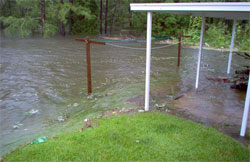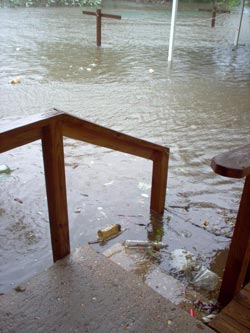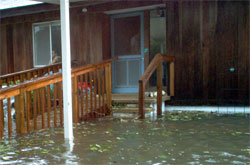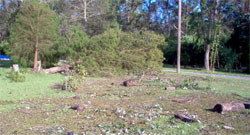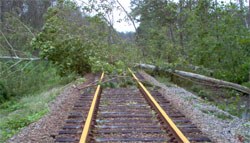![]() Archives
Archives
September 4, 2005
The television continues to show the suffering from Hurricane Katrina. While what we do will is only a small part in the entirety of all the needs, the little we do does make a big difference in the lives of those help.
We are in contact with Ken Giese in Houston and Paul Kieffer in Mobile, Alabama about urgent needs. We learned of an urgent need for wheelchairs for those in the Astrodome and LifeNets is immediately shipping ten wheelchairs from Indianapolis and places such as Georgia and California.
Ken Giese and the United Church of God volunteers are going to be distributing the first needed personal care items in a shelter along with working shifts in the Houston Astrodome today.
Just for everyone's information, CLOTHING is NOT needed in the Houston area. The Giese's have contacted the Red Cross and the Salvation Army - both have told us they do NOT need or want clothing donations - they have a warehouse FULL of clothing items. However, there is a need for knapsacks and suitcases. Most people came with nothing to put items into.
Keep checking this blog continually for updates. We have not even begun to assess what our part is in Louisiana and Mississippi.
Ken Giese also reported of Louisiana UCG members trapped in the attic of their home. They had no ax to break through the roof and waited for the waters to recede and then were brought to safety.
Paul Kieffer contacted me and said that they just had their power restored. Their telephone has been working and so he's been able to send out updates on on his blog at http://www.ucog.org/blog/ They have been going over to a neighbor's home to recharge their laptop computer's battery.
Thanks to everyone for contributions that have come online and through the mail. We are making certain that we fill urgent human needs immediately as is in our power.
Stay tuned for more.
September 3, 2005
Thanks to all who have given help. All financial donations are going to be used as quickly as possible to provide for necessities. Ken Giese in Houston is coordinating efforts to help Hurricane Katrina victims. As far as members of the United Church of God, he says, "it appears that no one is seriously injured, but many have property damage. We don't have specifics as yet but I hope to travel to Baton Rouge next week to meet with Rick Avent and Andy Burnett and discuss specifics. It looks like electric generators may be an item that could be used by several, but much depends upon the availability of fuel. Thanks again for your help and we will try to stay in touch.
Here is more from Paul Kieffer's blog at http://www.ucog.org/blog/
Gas lines and the "Wichita linemen"
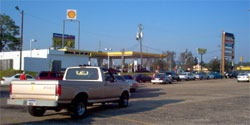
Although the situation improved a bit today, people have been waiting in line for up to four hours to buy gas here in Mobile. The two gas stations in the photo (Shell and Racetrac) are located at an exit from Interstate 10 about 5 miles from our house. Despite the dawn to dusk curfew, some people even lined up last night at one location and slept in their cars overnight to be near the front of the line to get gas. There were vendors walking down the line of cars in the morning, offering them breakfast snacks and hot coffee.
The line was pretty orderly, since there was a state
trooper on hand to watch and also direct traffic from the main road
into the line, which extended well into an adjacent shopping center
parking lot. Many of the license plates were from Mississippi, so
those folks had come over to Mobile to get gas. Several of those in
line filled up their cars and also gas cans to run their emergency
generators at home. Our neighbor has a pretty hefty generator, and
he hooked up a long extension cord so we can run our refrigerator,
which is a big help.
This evening we had some welcome visitors on Wooley Road. An electric utility vehicle from Kansas – I dubbed them the Wichita linemen – came down the road to clear all tree limbs off the power lines. The crew told us they had driven over 30 hours to get to Mobile, and when they are finished here their next stop will be in New Orleans. They are being lodged at the Mobile Convention Center along with a couple hundred other out-of-state linemen. Once the trees are cleared, Alabama Power can restore power, so perhaps in a day or two our power will be back on.
September 2, 2005
Today we made our first $3000 contribution towards immediate relief of hurricane victims. All money collected will be used directly for relief and reports will be given to our readers and supporters as to how it's being used.
We have been in touch with volunteers from Mobile, Alabama in the east to Houston in the west trying to find what initial course of action to take to help hurricane victims. Yesterday's contributions were in excess of $2500 and came mostly online.
We believe that we have found the best venue where to start helping immediately. We spoke with Kathy Giese, wife of pastor Ken Giese in Houston. She informed us about the following.
The Houston Astrodome will become the temporary home of more that 20,000 people displaced by Katrina. Since the Houston Church has worked with the concessionaire in their fund-raising program, they have asked the Houston church if they could supply volunteers to help serve meals to the folks living in the Astrodome.
Many other displaced people are being housed in churches, businesses and warehouses and other shelters. They are in need of basic necessities. There has been a need for the following items:
Baby food
Baby formula
Diapers
Drinking water in plastic bottles
Heat and eat foods (chili, stew, canned pasta, canned vegetables, etc.)
MRE's (meals ready to eat)
Paper goods (plates, cups, toilet paper, tissues)
Personal care items (toothpaste, toothbrushes, soap, shampoo, hand cream, mouthwash)
Single serving food items
Single serving snacks (pop tarts, cereal bars, etc.)
LifeNets decided to send our first $3000 to Houston for purchase of many of the above items and distribute them on Labor Day.
We have received offers from people to ship clothing and other goods. Most of the refugees are people below poverty level. Extra-large clothing is needed along with children's clothing. We need to count the cost of shipping versus obtaining the items locally, however, we are looking into shipping options.
At LifeNets we have been receiving many phone calls and email messages of support for us to effectively help the needy. One of my friends Debbie McKee who helped us by driving a U-Haul to Ground Zero in New York City in September 2001 (how quickly time has passed!) has a running blog and mentions us.
http://www.debspage.org/blog/archives/2005_09.htmlLifeNets KatrinaIf you're going to donate money to the Hurricane Katrina relief effort (and you should, if you can), may I suggest one organization through which you can donate and be certain that nearly 100% of your money will go to the effort? LifeNets, International is run by my dear friend Victor Kubik, who has used his influence, his time, his money, his network, his love to help suffering people from Ukraine, to Malawi, to Southeast Asia (during the Tsunami), to New York (after 9/11) and I have seen in person his work and his dedication to helping fellow humans in need. I've known Vic since 1999 (met him at Butler as he was trying to enroll a Russian girl he and his family were hosting in English classes), and I've worked on projects with him; I know his wife and his friends, and they are just amazing, incessantly giving, hard-working people. If you decide to donate through Vic's organization, I think you will be pleased with the follow-up; you will see and read exactly where your money is being spent and there will be photos and journals to share the work that is done. If you've already given to the Red Cross, or some other worthy organization, that's great. I just thought that if you are considering giving, but haven't yet, you might think of LifeNets. To donate by check, click HERE. To donate online, click HERE. To read the LifeNets Katrina Blog, click HERE. (To read about LifeNets' other programs, click HERE or HERE.) |
September 1, 2005
This morning I went to Rotary Club in downtown Indianapolis. We meet in the Red Cross Building. The entire discussion revolved around Katrina and what Rotary should do. In the Red Cross building where we met, 25 families from New Orleans were brought up for temporary resettling. More are on the way. No one seems to know where the bottom of this disaster is. People are still trying to find one another.
The immediate needs are for food, fuel, ice -- basic necessities and cash to purchase those items what we want. About $2000 has been donated to LifeNets in less than 24 hours. A few Rotarians wrote checks to LifeNets this morning.
LifeNets will find a way to distribute directly to the needy and will develop that process shortly.
Here is more from Paul Kieffer's blog about recovering in Mobile. You can go directly to his blog at http://www.ucog.org/blog/
September 1 A house full of bugs
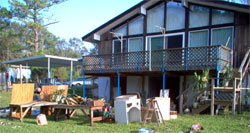 When
you have a flood, everything that does not survive in water looks
for higher ground. Including bugs – all kinds of them.
When
you have a flood, everything that does not survive in water looks
for higher ground. Including bugs – all kinds of them.
It is clean-up time in Mobile.
We notice all kinds of "extra" bugs in the house – spiders, tiny
flying insects and other critters that I am not familiar with, a
fire ant or two (with ant bites to prove it!), etc. Hey, they wanted
to survive, too, so some of them found refuge in the house. We and
our neighbors are busy getting everything out of the basement (in
our case) that was under water, getting out carpets, furniture, etc.
in the case of our neighbors.
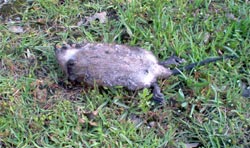
There is a strange stench in the air, like swamp muck, and it permeates everything. In cleaning up the debris in the yard, you have to watch out for dead creatures (like the rat in the picture). We got our damaged water pump hooked up yesterday so we can run it a couple of times a day to have water for flushing the toilets. However, everyone has been warned to drink only bottled water, so we a supply on hand that will last a few days. The gas price here has jumped by 30 percent. Indications from the power company are that it will be possibly some weeks before the electricity comes back on. All things considered – like the situation in New Orleans – we are doing fairly well.
August 31, 2005
Katrina hit the US Mainland Monday morning August 19th and wreaked havoc through Louisiana, Mississippi and Alabama. Perhaps thousands are dead. Damage is inestimable. This will not be just another recovery.
LifeNets wants to do its part in helping to relieve suffering and we are still assessing what we can and should do.
We have reports from two of my friends Jerold Aust and Paul Kieffer who lived through the sustained 100 miles plus winds in Mobile, Alabama. Both feel fortunate that they suffered as little as they did compared to people around them.
As we start our relief efforts we will run this blog to tell you the story about what we are going to do. At this writing we have no idea about what to do, but since we initiated this effort about $500 in donations have been made to start. Thank you!
From Gerald Aust in Mobile, Alabama
|
|
|
|
You can go directly to Paul Kieffer's blog at http://www.ucog.org/blog/
Hello Katrina! – Sunday, 10 a.m.
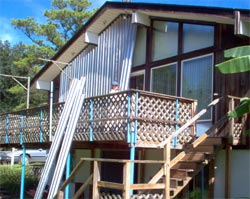 My brushes with bad weather on the Gulf Coast
over the last 30 years of visiting Mobile were limited
to a couple of tropical depressions and one tropical
storm. Last year I missed Ivan by one week, having
returned to Germany exactly 7 days before Ivan made
landfall just east of Mobile. In July some friends and I
made it to Mobile one day after Dennis made landfall, so
our flight from Atlanta was not disrupted.
My brushes with bad weather on the Gulf Coast
over the last 30 years of visiting Mobile were limited
to a couple of tropical depressions and one tropical
storm. Last year I missed Ivan by one week, having
returned to Germany exactly 7 days before Ivan made
landfall just east of Mobile. In July some friends and I
made it to Mobile one day after Dennis made landfall, so
our flight from Atlanta was not disrupted.
Katrina appears to be headed for New Orleans, already
a category 5 hurricane, packing winds over 170 mph
(270 kmh) and due to make landfall tomorrow at noon. So
it is time to put up the corrugated aluminum storm
shutters on the south (Gulf) side of the house. The wind
has already picked up a bit, making placement of the
longest pieces (at 14 feet) a challenge. The storm surge
is what could affect us the most, since we will be east
of landfall. The water in the yard is already up about
10 feet from shoreline, and that will increase as the
day goes on. Once we get all the shutters up, store
water and get the electric line ready for hook-up to an
emergency generator, it will time for Katrina to "bring
it on". The way things look, she won’t need any
encouraging!
![]()
Hello Katrina! – Sunday, 4 p.m.
When
a hurricane makes landfall on the Gulf Coast, the
northeast quadrant of the storm wit h its
counterclockwise circular movement has the highest winds
and storm surge. So if you are east of the point where
landfall occurs, you are especially in harm’s way. My
father-in-law built his house 14 feet
h its
counterclockwise circular movement has the highest winds
and storm surge. So if you are east of the point where
landfall occurs, you are especially in harm’s way. My
father-in-law built his house 14 feet
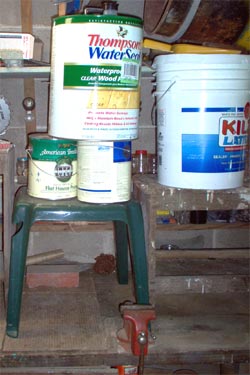 above median high
tide, so an awful lot of water has to back up Mobile Bay
before it would ever get to the level of the house
proper. But our basement floods on occasion, and so far
the worst hurricanes for flooding were Camille in 1969
and Georges in 1998. Both went ashore in Mississippi. Of
the two, Georges was worse water-wise, putting about 47
inches of rain in the basement.
above median high
tide, so an awful lot of water has to back up Mobile Bay
before it would ever get to the level of the house
proper. But our basement floods on occasion, and so far
the worst hurricanes for flooding were Camille in 1969
and Georges in 1998. Both went ashore in Mississippi. Of
the two, Georges was worse water-wise, putting about 47
inches of rain in the basement.
Actually, it was originally not a full basement. It was simply the space under the house, since the house is built on an incline and the incline is part of the elevation needed to be well above median high tide level. When the house was built in 1964, only about the first 40 feet of the basement away from the south entrance were excavated, providing an area where my father-in-law – an architect – could store his tools. The rest of the basement to the other side of the house was just a crawl space of sorts, and dirt at that. When my father-in-law retired, he made one of his first projects the "completion" of the basement, which he accomplished by carting out all the dirt to make a stand-up basement under the entire house. Then he put a concrete floor in with a spacing for ground water to seep up during heavy rains. Knowing how high the flooding was with Camille and Georges gives us a measuring stick, so we just put everything valuable higher than 47 inches, stacking it on shelves or on my father-in-law’s old workbench, like you can see in the picture. Once that is done and the house is shuttered up, you have done everything you can do to be ready – this time for Katrina.
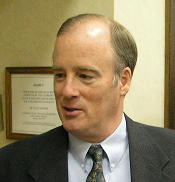
 Wind conditions here will deteroriate the next six hours.
We continue to wonder about the surge. Much of coastal Alabama was
evacuated yesterday when officials warned that Katrina could bring
record flood levels to Mobile’s downtown riverfront and leave some city
roads under water. Mobile’s mayor Dow said the possible flooding could
be worse than the 9-foot surge that soaked downtown and turned a key
interstate connector into a lake during Hurricane Georges in 1998. That
was the hurricane that put 47 inches of water into our basement.
Meanwhile we share our living room with the equipment that normally is
in the basement, like the lawnmowers in the photo. The photo is for
Jesmina’s benefit, who might be concerned about the effect Katrina will
have on my grass-cutting activities.
Wind conditions here will deteroriate the next six hours.
We continue to wonder about the surge. Much of coastal Alabama was
evacuated yesterday when officials warned that Katrina could bring
record flood levels to Mobile’s downtown riverfront and leave some city
roads under water. Mobile’s mayor Dow said the possible flooding could
be worse than the 9-foot surge that soaked downtown and turned a key
interstate connector into a lake during Hurricane Georges in 1998. That
was the hurricane that put 47 inches of water into our basement.
Meanwhile we share our living room with the equipment that normally is
in the basement, like the lawnmowers in the photo. The photo is for
Jesmina’s benefit, who might be concerned about the effect Katrina will
have on my grass-cutting activities.
